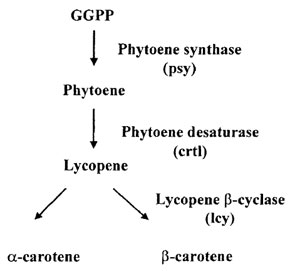For the developing world
The world-wide deficiency of vitamin A is being tackled both through conventional plant breeding and by genetic manipulation. However, the use of conventional plant breeding to deliver adequate intakes is dependent on availability of carotenoid-rich staple foods. Often these are available for very restricted times of the year in some societies. In those countries where rice is a dietary staple the problem is particularly severe and the deficiency is likely to be corrected only by the introduction of rice that has been genetically manipulated to produce β-carotene. However, yellow rice is produced and this may give rise to problems of acceptability to consumers used to white rice.Manipulation of the carotenoid pathway in rice
The nature of the challenges faced in manipulating plant secondary metabolites is well illustrated through the attempts that have been made to produce carotenoids in rice plants. A simplified version of the pathways leading to the synthesis of the carotenoids principally found in food plants is shown in Fig. 7.2.
Immature rice endosperm is capable of synthesising the early pathway intermediate geranylgeranyl diphosphate (GGDP). Four plant genes corresponding to the enzymes phytoene synthase (psy) (1), phytoene desaturase (2), zeta carotene desaturase (3) and lycopene cyclase (crt) (4) are required. Enzyme (1) was obtained from the daffodil (Narcissus pseudonarcissus), (2) from a bacterium Erwinia uredovora – which is capable of achieving steps (2) and (3) from the single enzyme, and (4) from the daffodil.
The genes need to be expressed in a tissue-specific manner through the insertion of specific promoters. This has been achieved in rice through the use of the daffodil psy gene [19]. In rice the daffodil psy cDNA insertion is under the control of an endosperm-specific promoter. The choice of promoter will very much affect the timing and tissue-specific expression of a gene.
Surprisingly, seeds that expressed psy and crt did not accumulate lycopene. Instead they contained β-carotene and other xanthophylls. Thus it would seem that the enzymes required to make these metabolites are either normally expressed in rice endosperm or are induced if lycopene is formed. The maximum level of carotenoids in the endosperm of plants that were heterozygous for the transgenes was 1.6 mg kg-1 which is likely to help to meet the nutritional needs of people consuming rice as a staple. Interestingly, good progress is being made in adding a gene coding for ferritin – the iron storageprotein found in mammalsand plants– to rice [20]. It is likely that this would also help improve the iron deficiency also seen in these communities if it is shown to be bioavailable.
The controversy over the use of advanced technologies for producing sustainable food in the developing world has been addressed by the developers of modified rice. They have in effect waived all intellectual property rights for exploitation of the technologies in the developing world, and are actively involved in assisting the International Rice Research Institute to breed stable and agronomically successful lines for use in vitamin A-deficient areas.





